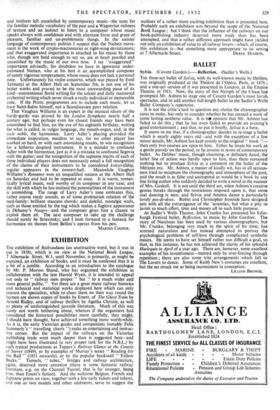EXHIBITION
THE exhibition of Railroadiana (an unattractive word, but it was in use in 1838), which is on view at the National Book League, 7 Albemarle Street, W.1, until November, is primarily, as might be expected, an exhibition of books, and it must be confessed that it is a bit of a jumble. According to an introduction to the catalogue by Mr. P. Morton Shand, who has organised the exhibition in collaboration with the late Harold Wyatt, it is intended to appeal not only to " railway men proper " but " to a much wider and more general public." Yet there are a great many railway histories and technical and statistical works displayed here which can only interest the specialists, while to cheer them on their way round the laymen are shown copies of books by Emett, of The Ghost Train by Arnold Ridley, and of railway thrillers by Agatha Christie, as well as plenty of undistinguished juvenile literature. Much of this was surely not worth bothering about, whereas if the organisers had considered the historical possibilities more carefully, they might, 1 should have thought, have achieved something more worth-while. As it is, the early Victorian guides and companions (notably Felix Surnmerly's " travelling charts ") make an entertaining and instruc- tive corner. But the impact of the railways on the Victorian publishing trade went much deeper than is suggested here—and might have been illustrated (a very proper task for the N.B.L.) by such typical productions as Tupper's Railway Glance at the County of Surrey (1849), or by examples of Murray's series " Reading for the Rail " (1851 onwards), or by the popular bookstall " Yellow Backs." Tunnels, " tubes," bridges and railway architecture, again, deserved more attention (there is some fantastic railway literature, e.g. on the Channel Tunnel, that is far stranger, being true, than Emett's fiction). And the welcome Belgian, French and Japanese prints on view, together with a few early tickets and tokens, and one or two models and other oddments, serve to suggest the outlines of a rather more exciting exhibition than is presented here. Probably such an exhibition was beyond the scope of the National Book League ; but I think that the influence of the railways on our book-publishing industry deserved more study than has been attempted, and that a rather different approach might have yielded not only an exhibition of value to all railway lovers—which, of course, this exhibition is—but something more appropriate to its setting


































 Previous page
Previous page